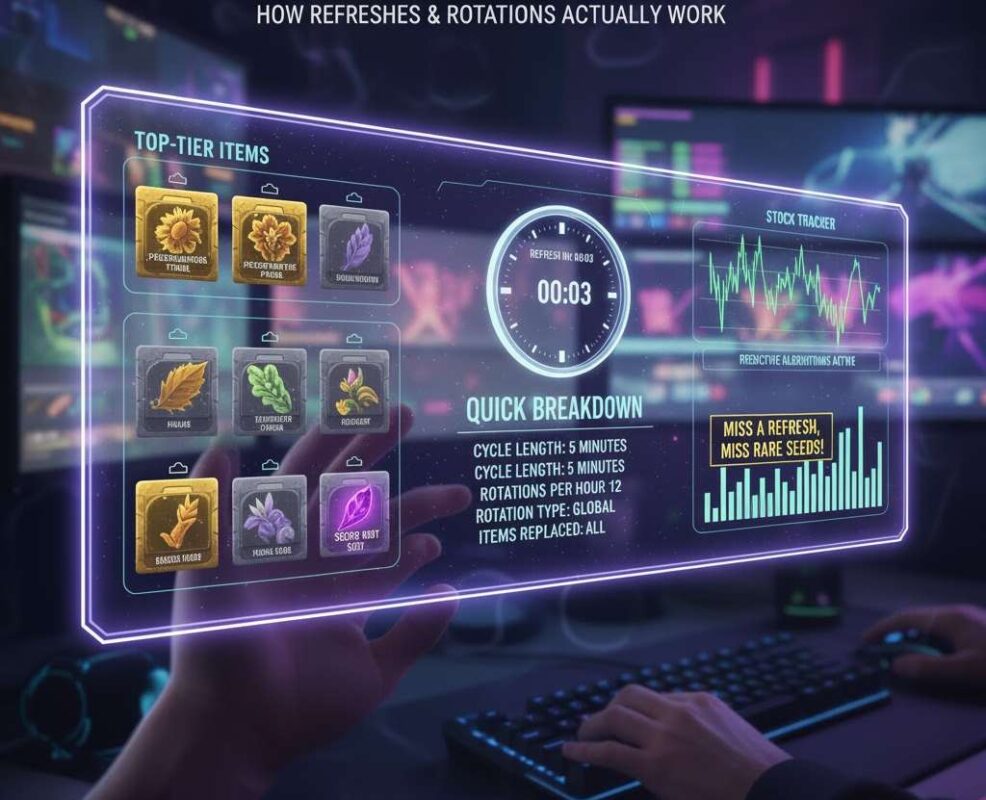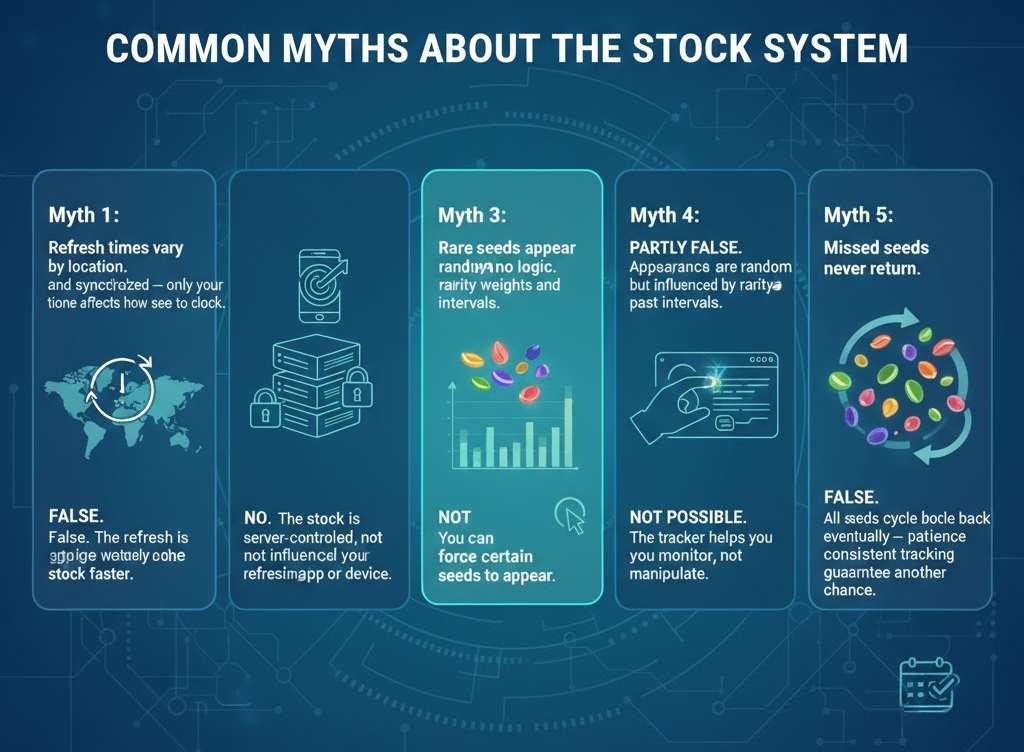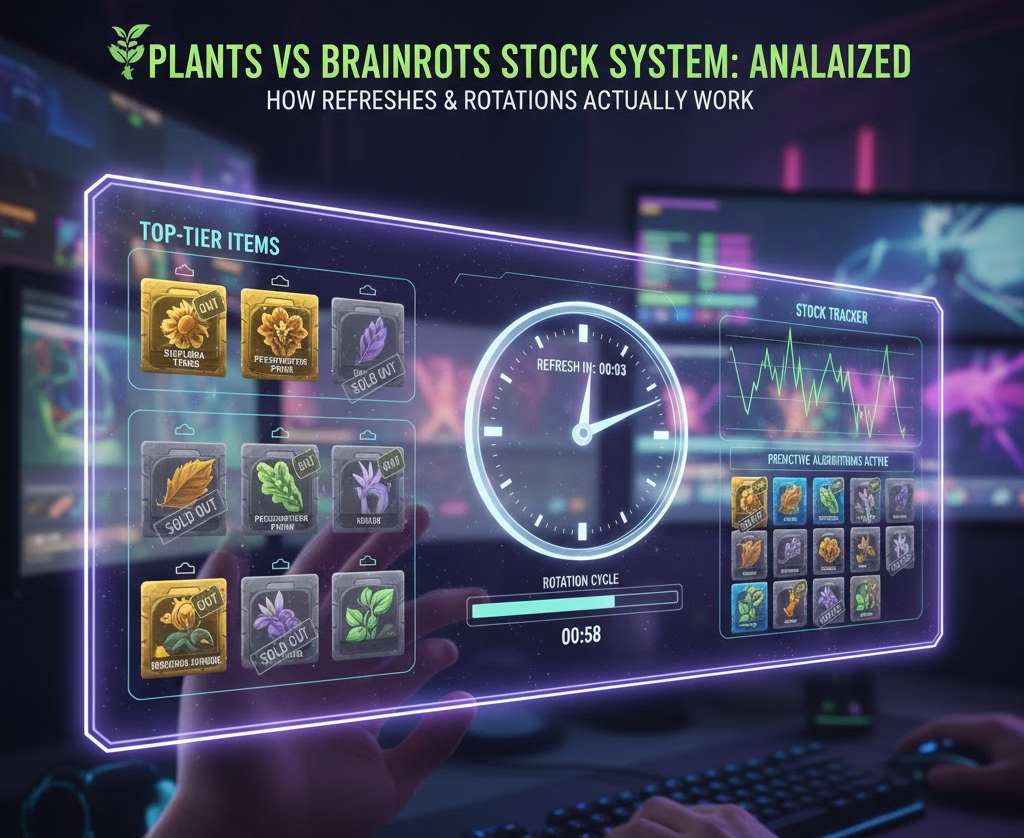Every Plants vs Brainrots player knows the feeling — you open the shop, spot a rare seed, and before you can buy it, it’s gone. The shop’s rotation moves so quickly that most players miss out on top-tier items. But behind that speed lies a pattern — one you can track, study, and even predict.
This blog unpacks how the Plants vs Brainrots stock system works, what triggers refreshes, and how the Plants vs Brainrots Stock Tracker helps you stay in sync with every update.
Understanding the Stock System
The in-game shop runs on a time-based rotation system. It’s split into two main categories: Seeds and Gear. Both follow the same rule — the shop refreshes every five minutes, replacing existing items with new ones from the rotation pool.
That means every hour brings twelve new updates, each one with a chance to feature rare seeds such as Mythic or Secret ones. Miss a refresh, and you might wait hours before seeing that seed again.
Here’s what the system does every few minutes:
- Resets stock for both Seeds and Gear.
- Pulls new items from the entire database.
- Applies rarity weights, giving common seeds more chances to appear than rare ones.
- Updates globally, meaning every player sees the same items at the same time.
The rotation is quick and fair — everyone gets equal access. The challenge lies in being fast enough to grab rare seeds before the next refresh hits.
How Refreshes Actually Work

The refresh timer is fixed. It’s not random or region-based — it’s global and synchronised across all players. When the timer reaches zero, the entire stock resets instantly.
Quick Breakdown
- Cycle length: 5 minutes
- Rotations per hour: 12
- Rotation type: Global
- Items replaced: All seeds and gear simultaneously
For example, if a refresh happens at 2:00 PM, the next will occur at 2:05, then 2:10, and so on. Each new cycle gives the shop an entirely new lineup.
Because the window is so short, missing even one refresh could mean losing your chance at a rare Secret seed that might not reappear for hours.
Rarity and Rotation Frequency
The stock system uses rarity tiers to decide which items appear more often. Common and Epic seeds rotate frequently, while Mythic and Secret ones are coded for lower visibility — making them highly desirable.
| Rarity Tier | Typical Frequency | Example Items |
| Common | Every few rotations | Basic starter seeds |
| Epic | Several times per hour | Mid-level seeds |
| Legendary | 1–2 times daily | High-value seeds |
| Mythic | Once daily or less | Unique advanced seeds |
| Secret | Unpredictable | Ultra-rare hidden seeds |
This balance ensures constant excitement. Every refresh could bring something special, but only a few appear rarely enough to spark real demand.
What the Tracker Adds to the System
The Plants vs Brainrots Stock Tracker monitors these refreshes automatically. It connects to the official Discord API, which broadcasts live stock data as it changes. Every time the shop refreshes, the tracker updates instantly.
Here’s what the tracker offers:
- Live Stock Display: Shows current seeds and gear in real time.
- Automatic Refreshes: Updates every five minutes without manual action.
- Rarity Indicators: Colour-coded labels to identify valuable items fast.
- “Last Seen” Data: Timestamps showing when each seed was last available.
- Simultaneous Tracking: Monitors both the Seed and Gear shops together.
The tracker turns guesswork into strategy. Instead of constantly checking the game, you can keep the tracker open and act when a target item appears.
Power of “Last Seen” Data
One underrated feature of the tracker is its Last Seen timestamp. It records when a specific seed or gear item last appeared in stock.
With time, this data becomes your best prediction tool. You’ll start noticing rhythms — a Mythic seed might reappear every few hours, or a Secret one might return at similar intervals each day.
Example:
- Mr Carrot last appeared 7 hours ago. If its usual gap is 6–8 hours, you know it’s due soon.
- Mango Seed tends to show twice a day — morning and late evening.
Tracking this way turns refreshes into patterns rather than pure luck.
How Rotation Predictability Works
While the stock updates are randomised, they still follow probabilities tied to rarity. The longer an item hasn’t appeared, the higher its likelihood to show up in upcoming cycles.
That’s why experienced players don’t rely on random checks — they rely on timing. The Plants vs Brainrots Stock Tracker helps map those intervals, giving you insight into when a seed might surface next.
It’s not a perfect prediction, but it’s close enough to plan efficiently.
Global Synchronisation and Player Advantage
Because refreshes are global, every player sees the same rotation. The moment a rare seed appears, thousands of players might race to buy it.
That’s where the tracker gives you an advantage. It updates within seconds of the rotation, meaning you can see new stock and act instantly — long before word spreads through Discord or community channels.
The difference between spotting a drop instantly and checking two minutes late can decide who gets the Secret seed.
Gear Stock vs Seed Stock
Though both rotate together, they serve different purposes.
- Seed Stock: The main draw — these determine your growth and strength.
- Gear Stock: Equipment and tools that boost your plant’s performance.
Gear items rotate from a smaller pool so that high-tier ones may repeat more often. Still, tracking both ensures you don’t overlook upgrades that complement rare seeds.
Common Myths About the Stock System

| Myth | Statement | Truth |
|---|---|---|
| 1 | Refresh times vary by location. | False. The refresh is global and synchronized — only your time zone affects how you see the clock. |
| 2 | Manual refreshes change stock faster. | False. The stock is server-controlled, not influenced by refreshing your app or device. |
| 3 | Rare seeds appear randomly with no logic. | Partly false. Appearances are random but influenced by rarity weights and past intervals. |
| 4 | You can force certain seeds to appear. | Not possible. The tracker helps you monitor, not manipulate. |
| 5 | Missed seeds never return. | False. All seeds cycle back eventually — patience and consistent tracking guarantee another chance. |
How to Use Stock Data Strategically
To make the most of the tracker and rotation system:
- Monitor “Last Seen” timestamps. Track when high-value seeds last appeared.
- Set alerts for rare tiers. Focus on Mythic and Secret seeds to avoid notification overload.
- Oversee the refresh minutes. Keep the tracker open 30 seconds before each cycle.
- Note recurring gaps. Many players discover regular intervals for specific seeds.
- Balance seed and gear focus. Don’t miss rare gear while chasing seeds.
Consistency matters more than luck — staying aware of every cycle is what keeps you ahead.
Why Understanding Rotations Matters
Once you understand how refreshes work, Plants vs Brainrots becomes less about chance and more about precision. You start recognising trends instead of reacting unthinkingly.
Players using the Plants vs Brainrots Stock Tracker no longer hope for drops — they anticipate them. They track intervals, prepare before refreshes, and buy faster than others.
That awareness turns the fast-paced refresh system into a predictable rhythm — and those who master it control the shop, not the other way around.
Final Thoughts
The Plants vs Brainrots stock system is fast, fair, and data-driven. With refreshes every five minutes and rarity-based rotations, it rewards players who stay alert.
The Plants vs Brainrots Stock Tracker takes the guesswork out of the process. It updates live, records “Last Seen” data, and helps you plan every move with precision.
Keep it open, study the refresh cycle, and react instantly when your target appears. Because in Plants vs Brainrots, the most brilliant player isn’t the luckiest — it’s the one who understands how the system truly works.

